D?m?si P., Nehaniv C.L. Algebraic Theory of Automata Networks. An Introduction
Подождите немного. Документ загружается.

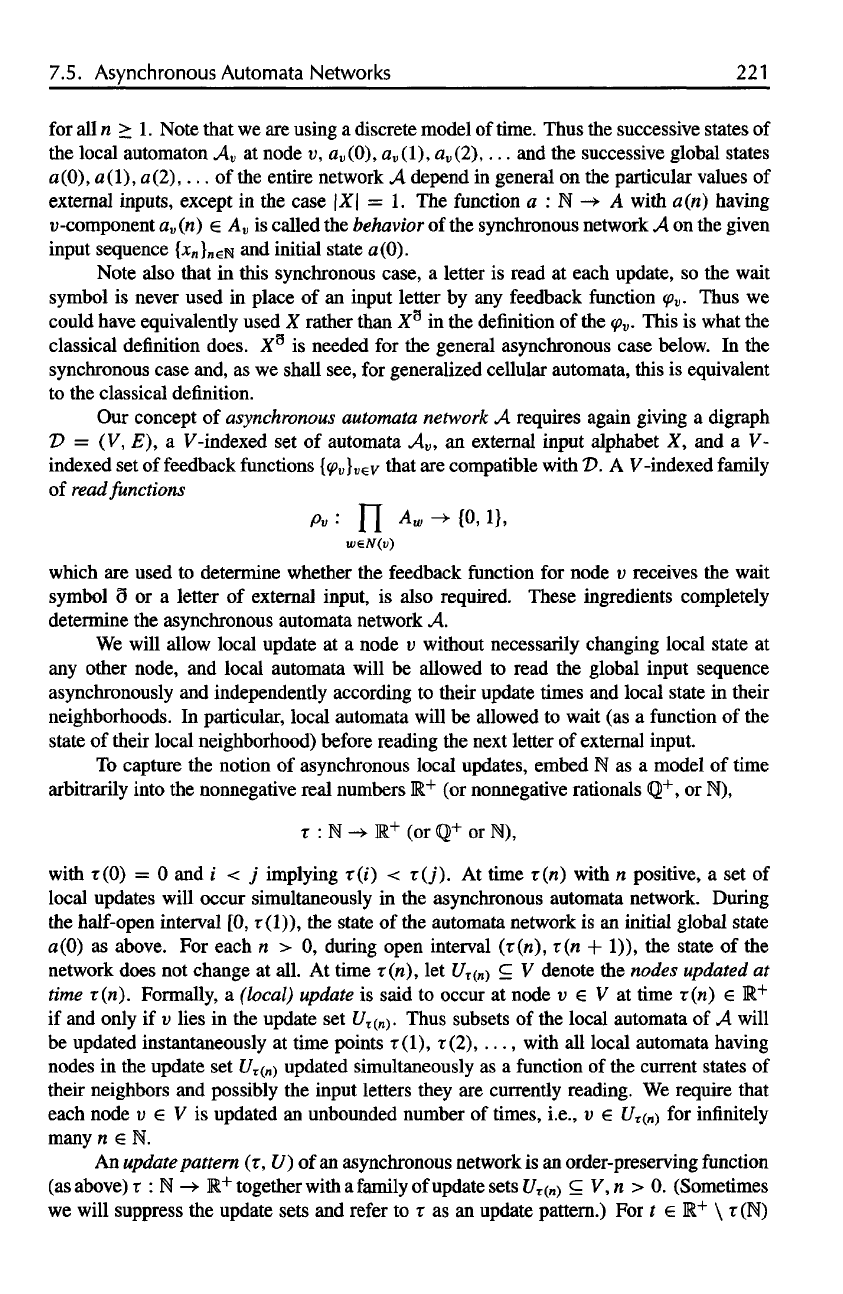
7.5.
Asynchronous
Automata Networks
221
for
alFn
> 1.
Note that
we are
using
a
discrete model
of
time. Thus
the
successive states
of
the
local automaton
A
v
at
node
v,
a
v
(0),
a
v
(l),
a
v
(2),...
and the
successive global states
o(O),
a(l),
a
(2),...
of the
entire network
A
depend
in
general
on the
particular values
of
external inputs,
except
in the
case
\X\ = 1. The
function
a : N -> A
with a(n) having
u-component
a
v
(n)
e A
v
is
called
the
behavior
of the
synchronous network
A on the
given
input sequence
{.x,,}
we
N
and
initial state
a(0).
Note also that
in
this synchronous case,
a
letter
is
read
at
each update,
so the
wait
symbol
is
never used
in
place
of an
input letter
by any
feedback
function
<p
v
.
Thus
we
could have equivalently used
X
rather than
X
9
in the
definition
of the
<p
v
.
This
is
what
the
classical definition does.
X® is
needed
for the
general asynchronous case below.
In the
synchronous case and,
as we
shall
see,
for
generalized cellular automata, this
is
equivalent
to the
classical definition.
Our
concept
of
asynchronous
automata
network
A
requires again giving
a
digraph
T>
= (V, E), a
V-indexed
set of
automata
A
v
, an
external input alphabet
X, and a V-
indexed
set of
feedback
functions
{(p
v
}
v
^v
that
are
compatible with
A
V-indexed
family
of
read
functions
which
are
used
to
determine whether
the
feedback
function
for
node
v
receives
the
wait
symbol
9 or a
letter
of
external input,
is
also
required.
These
ingredients
completely
determine
the
asynchronous automata network
A.
We
will allow local update
at a
node
v
without necessarily changing
local
state
at
any
other node,
and
local automata will
be
allowed
to
read
the
global input sequence
asynchronously
and
independently according
to
their update times
and
local state
in
their
neighborhoods.
In
particular,
local
automata will
be
allowed
to
wait
(as a
function
of the
state
of
their local neighborhood) before reading
the
next letter
of
external input.
To
capture
the
notion
of
asynchronous
local
updates, embed
N as a
model
of
time
arbitrarily into
the
nonnegative real numbers
R
+
(or
nonnegative rationals
Q
+
, or N),
with
r(0)
=0 and i < j
implying
r(i)
<
T(J).
At
time
t(ri)
with
n
positive,
a set of
local updates will occur simultaneously
in the
asynchronous automata network. During
the
half-open interval
[0,
r(l)),
the
state
of the
automata network
is an
initial
global state
a(0)
as
above.
For
each
n > 0,
during open interval (r(n),
r(n +
1)),
the
state
of the
network
does
not
change
at
all.
At
time
r(n),
let
U
T
(
n
)
^ V
denote
the
nodes
updated
at
time
r(n).
Formally,
a
(local)
update
is
said
to
occur
at
node
v 6 V at
time
r(n)
e R
+
if
and
only
if v
lies
in the
update
set
U
r
(
n
).
Thus subsets
of the
local
automata
of A
will
be
updated instantaneously
at
time points
r(l), r(2), ...,
with
all
local
automata having
nodes
in the
update
set
U
T
(
K
)
updated simultaneously
as a
function
of the
current states
of
their neighbors
and
possibly
the
input letters they
are
currently reading.
We
require that
each node
v e V is
updated
an
unbounded number
of times,
i.e.,
v €
U
r
(
n
)
for
infinitely
many
n e N.
An
update
pattern
(T, V) of an
asynchronous network
is an
order-preserving function
(as
above)
T : N ->• R
+
together with
a
family
of
update sets
U
T
(
n
)
V,n > 0.
(Sometimes
we
will suppress
the
update sets
and
refer
to r as an
update pattern.)
For t e R
+
\
r(N)
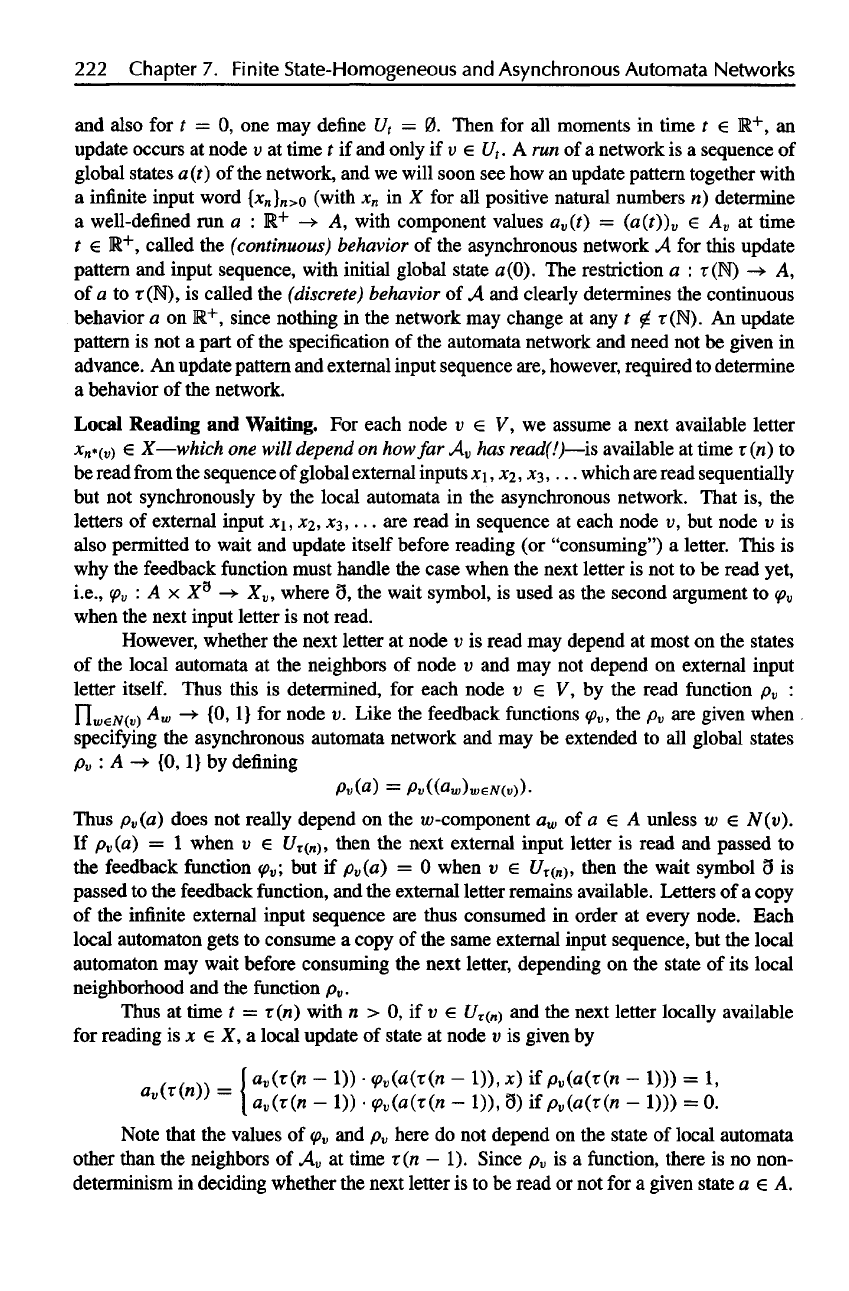
222
Chapter
7.
Finite
State-Homogeneous
and
Asynchronous
Automata Networks
and
also
for t = 0, one may
define
U
t
= 0.
Then
for all
moments
in
time
t e R
+
, an
update
occurs
at
node
v at
time
t if and
only
if v e U
t
. A run of a
network
is a
sequence
of
global
states a(t)
of the
network,
and we
will soon
see how an
update pattern together with
a
infinite
input word
[x
n
}
n>
o
(with
x
n
in X for all
positive natural numbers
n)
determine
a
well-defined
run a : E
+
-> A,
with component values #„(?)
=
(o(O)u
e A^ at
time
t e R
+
,
called
the
(continuous)
behavior
of the
asynchronous network
A for
this update
pattern
and
input sequence, with initial global state a(0).
The
restriction
a :
r(N)
-» A,
of
a to
r(N),
is
called
the
(discrete)
behavior
of ^4 and
clearly determines
the
continuous
behavior
a on R
+
,
since nothing
in the
network
may
change
at any t g
r(N).
An
update
pattern
is not a
part
of the
specification
of the
automata network
and
need
not be
given
in
advance.
An
update pattern
and
external input sequence are, however, required
to
determine
a
behavior
of the
network.
Local
Reading
and
Waiting.
For
each node
v e V, we
assume
a
next available
letter
*„*(„)
€.
X—which
one
will
depend
on how far A
v
has
read(!)—is
available
at
time r(n)
to
be
read
from
the
sequence
of
global external inputs
x\, *2,
£3,... which
are
read sequentially
but
not
synchronously
by the
local
automata
in the
asynchronous network. That
is, the
letters
of
external input
x\,
X2,
x$,...
are
read
in
sequence
at
each node
v, but
node
v is
also permitted
to
wait
and
update itself before reading
(or
"consuming")
a
letter.
This
is
why
the
feedback
function
must handle
the
case when
the
next letter
is not to be
read yet,
i.e.,
<p
v
: A x X
s
-» X
v
,
where
5, the
wait symbol,
is
used
as the
second argument
to
tp
v
when
the
next input
letter
is not
read.
However, whether
the
next letter
at
node
v is
read
may
depend
at
most
on the
states
of
the
local
automata
at the
neighbors
of
node
v and may not
depend
on
external input
letter
itself. Thus this
is
determined,
for
each node
v e V, by the
read
function
p
v
:
YlweN(v)
AW
-»•
{0,1}
for
node
v.
Like
the
feedback
functions
tp
v
,
the p
v
are
given when
specifying
the
asynchronous automata network
and may be
extended
to all
global states
p
v
: A ->
{0,1}
by
defining
Thus
p
v
(a) does
not
really depend
on the
w-component
a
w
of a € A
unless
w e
N(v).
If
p
v
(d)
= 1
when
v e
U
r
(
n
),
then
the
next external input
letter
is
read
and
passed
to
the
feedback
function
<p
v
;
but if
p
v
(a)
= 0
when
v €
U
T
(
n
),
then
the
wait symbol
9 is
passed
to the
feedback
function,
and the
external letter remains available. Letters
of a
copy
of
the
infinite
external input sequence
are
thus consumed
in
order
at
every node. Each
local
automaton gets
to
consume
a
copy
of the
same external input sequence,
but the
local
automaton
may
wait before consuming
the
next letter, depending
on the
state
of its
local
neighborhood
and the
function
p
v
.
Thus
at
time
t =
r(n) with
n > 0, if v e
U
T
(
n
)
and the
next
letter
locally available
for
reading
is x e X, a
local
update
of
state
at
node
v is
given
by
Note that
the
values
of
<p
v
and p
v
here
do not
depend
on the
state
of
local
automata
other than
the
neighbors
of A
v
at
time
r(n — 1).
Since
p
v
is a
function,
there
is no
non-
determinism
in
deciding whether
the
next letter
is to be
read
or not for a
given state
a e A.
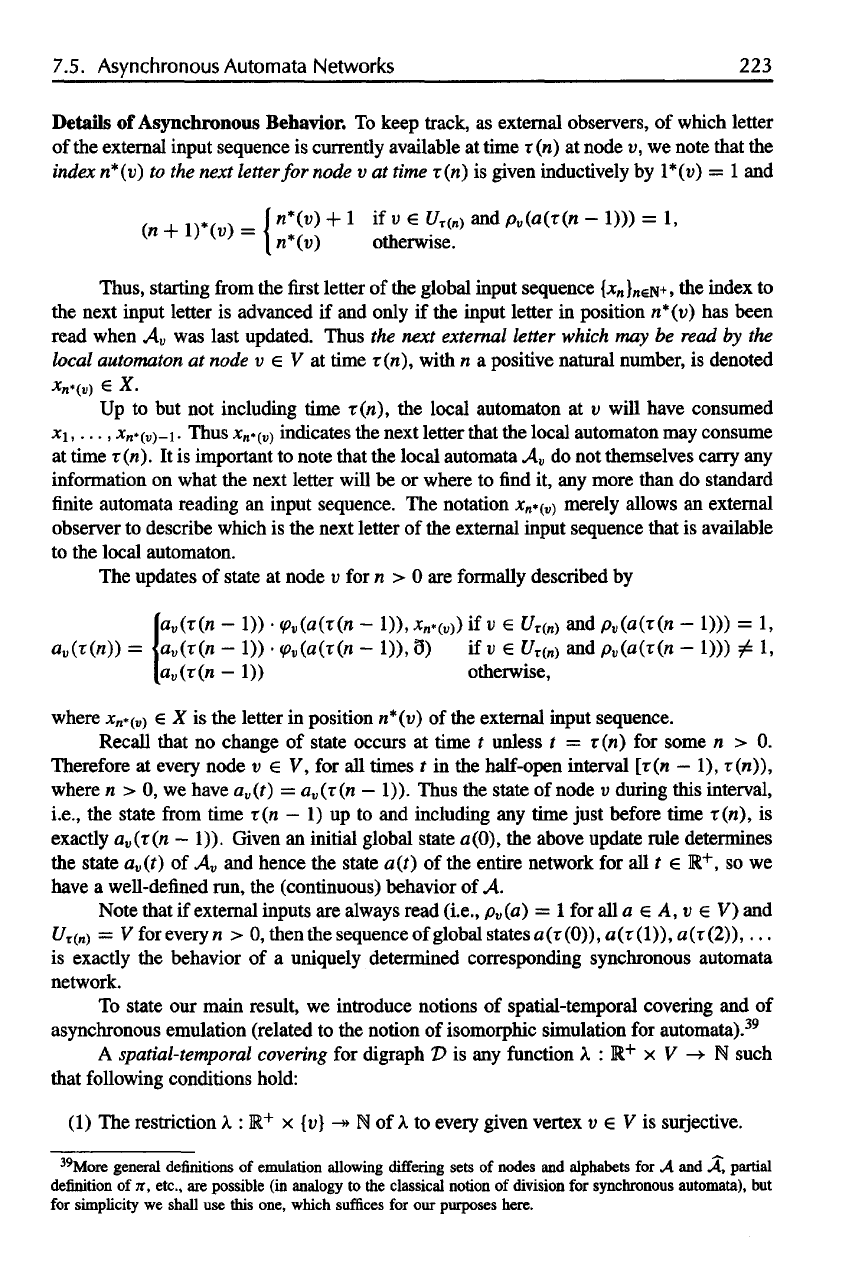
7.5.
Asynchronous
Automata Networks
223
Details
of
Asynchronous
Behavior.
To
keep track,
as
external observers,
of
which letter
of
the
external input sequence
is
currently available
at
time
r (n) at
node
v, we
note that
the
index
n*(v)
to the
next
letter
for
node
v at
time
r(«)
is
given inductively
by
l*(v)
= 1 and
Thus, starting
from
the first
letter
of the
global input sequence
{*
n
}n6N
+
>
the
index
to
the
next input letter
is
advanced
if and
only
if the
input letter
in
position
n*(u)
has
been
read when
A
v
was
last updated. Thus
the
next
external
letter which
may be
read
by the
local
automaton
at
node
v e V at
time r(n), with
n a
positive natural number,
is
denoted
*n*(u)
€ X.
Up
to but not
including time T(«),
the
local
automaton
at v
will have consumed
x\,...,
jc
n
*(
v
)_i.
Thus
*„.(„)
indicates
the
next
letter
that
the
local
automaton
may
consume
at
time r(h).
It is
important
to
note that
the
local
automata
A
v
do not
themselves carry
any
information
on
what
the
next letter will
be or
where
to find it, any
more than
do
standard
finite
automata
reading
an
input sequence.
The
notation
jc
w
*(
v)
merely allows
an
external
observer
to
describe which
is the
next letter
of the
external input sequence that
is
available
to
the
local automaton.
The
updates
of
state
at
node
v for n > 0 are
formally described
by
where
*„*(„)
e X is the
letter
in
position n*(u)
of the
external input sequence.
Recall that
no
change
of
state occurs
at
time
t
unless
t =
r(n)
for
some
n > 0.
Therefore
at
every node
v e V, for all
times
r in the
half-open interval [r(n
—
1),
r(n)),
where
n > 0, we
have a
v
(t)
=
a
v
(x(n
—
1)). Thus
the
state
of
node
v
during this interval,
i.e.,
the
state
from
time r(n
—
1) up to and
including
any time
just before
time
r(n),
is
exactly
a
v
(r(n
—
1)). Given
an
initial
global state a(0),
the
above update rule determines
the
state a
v
(t)
of A
v
and
hence
the
state a(t)
of the
entire network
for all t e R
+
, so we
have
a
well-defined run,
the
(continuous) behavior
of A.
Note
that
if
external inputs
are
always read (i.e., p
v
(a)
= 1 for all a e A, v e V) and
U
r
(
n
)
= V
foreveryn
> 0,
then
the
sequence
of
global states
a(r(0)),a(r(l)),a(r(2)),...
is
exactly
the
behavior
of a
uniquely determined corresponding synchronous automata
network.
To
state
our
main result,
we
introduce notions
of
spatial-temporal covering
and of
asynchronous emulation (related
to the
notion
of
isomorphic simulation
for
automata).
39
A
spatial-temporal
covering
for
digraph
D is any
function
A,
: R
+
x V -> N
such
that
following conditions hold:
(1) The
restriction
A :
M.
+
x [v] -» N of
A.
to
every given vertex
v e V is
surjective.
39
More
general
definitions
of
emulation allowing
differing
sets
of
nodes
and
alphabets
for A and A,
partial
definition
of it,
etc.,
are
possible
(in
analogy
to the
classical notion
of
division
for
synchronous automata),
but
for
simplicity
we
shall
use
this one, which
suffices
for our
purposes here.
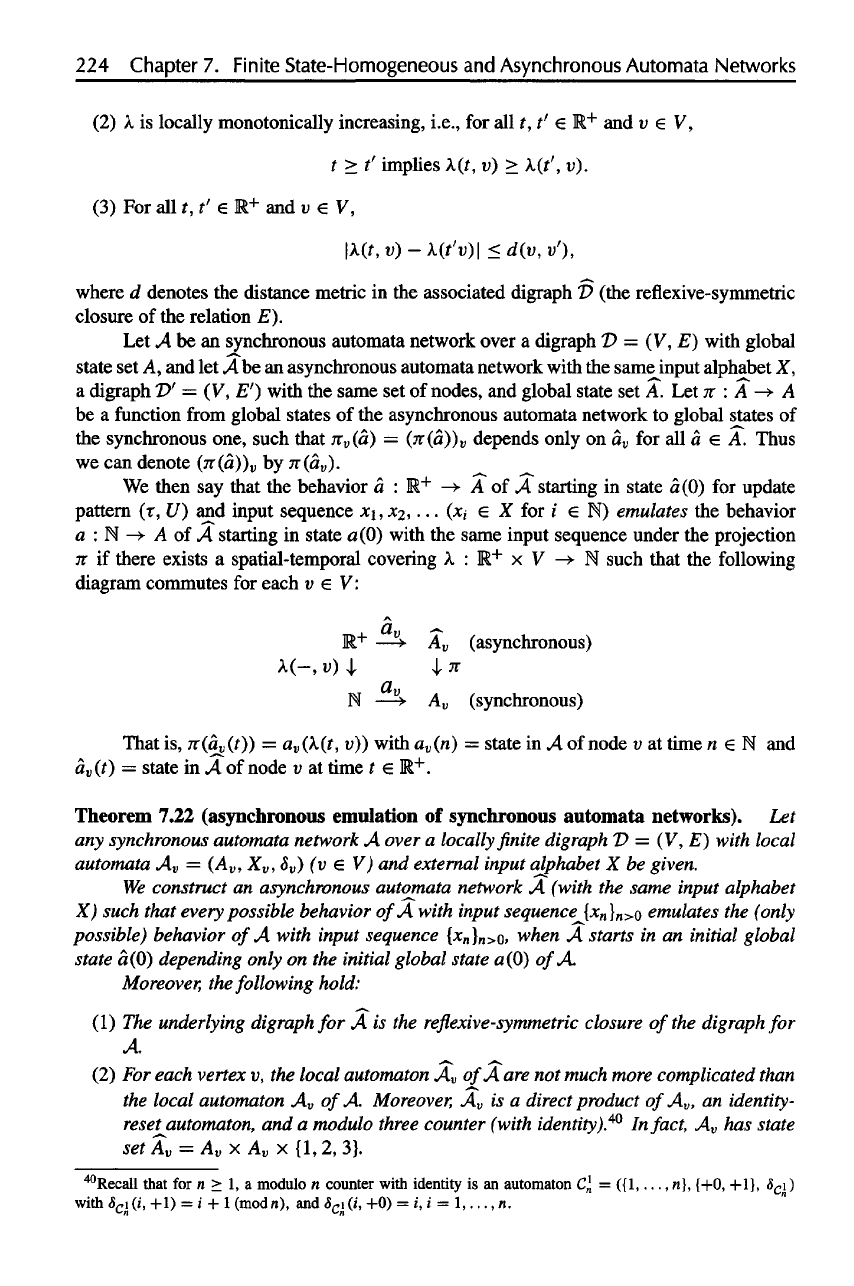
224
Chapter
7.
Finite State-Homogeneous
and
Asynchronous Automata Networks
(2)
A is
locally monotonically increasing, i.e.,
for all t, t' e R
+
and v e V,
(3)
For all t, t' e R+ and v € V,
where
d
denotes
the
distance
metric
in the
associated
digraph
T>
(the reflexive-symmetric
closure
of the
relation
E)•
Let
A be an
synchronous automata network over
a
digraph
= (V, E)
with
global
state
set A, and let A be an
asynchronous automata network with
the
same input alphabet
X,
a
digraph
T>'
= (V, E')
with
the
same
set of
nodes,
and
global
state
set A. Let
TT
: A
—>
A
be a
function from
global
states
of the
asynchronous automata network
to
global states
of
the
synchronous one, such that
(a) =
(n(a))
v
depends only
on a
v
for all a e A.
Thus
we
can
denote (n(a))
v
by
n(a
v
).
^
We
then
say
that
the
behavior
a : E
+
->• A of A
starting
in
state a(0)
for
update
pattern
(r, U) ami
input
sequence
x\,
*2,...
(*, € X for / € N)
emulates
the
behavior
a
: N -> A of A
starting
in
state a(0) with
the
same input sequence under
the
projection
n if
there
exists
a
spatial-temporal
covering
A.
: E
+
x V -» N
such that
the
following
diagram commutes
for
each
v € V:
That
is,
7r(flj,(0)
=
a
v
(k(t,
v))
with a
v
(n)
=
state
in A of
node
v at
time
n e N and
a
v
(t)
=
state
in A of
node
v at
time
t € R
+
.
Theorem
7.22
(asynchronous
emulation
of
synchronous
automata
networks).
Let
any
synchronous automata network
A
over
a
locally
finite
digraph
T>
= (V, E)
with local
automata
A
v
=
(A
v
, X
V
,S
V
)
(v e V) and
external input alphabet
X be
given.
We
construct
an
asynchronous automata network
A
(with
the
same input alphabet
X)
such that every possible behavior
of
A
with input sequence [x
n
}
n>
o emulates
the
(only
possible) behavior
of
A
with input sequence
[x
n
}
n>
Q,
when
A
starts
in an
initial global
state
a (0)
depending only
on the
initial global state a(0)
of
A.
Moreover,
the
following hold:
(1) The
underlying digraph
for A is the
reflexive-symmetric
closure
of
the
digraph
for
A
(2) For
each vertex
v, the
local automaton
A
v
of
A are not
much more complicated than
the
local automaton
A
v
of
A.
Moreover,
A
v
is a
direct product
of
A
v
, an
identity-
reset^automaton,
and a
modulo three counter (with identity).
40
In
fact,
A
v
has
state
set
A
v
= A
v
x A
v
x {1, 2, 3}.
^Recall
that forn
> 1, a
modulo
n
counter with identity
is an
automaton
C\ =
({1,...,
n},
{+0, +1}, S
c
\)
with
S
c
i (i, +1) = i + 1
(rnodn),
and &
c
\ (i, +0) = i, i =
1,...,
n.
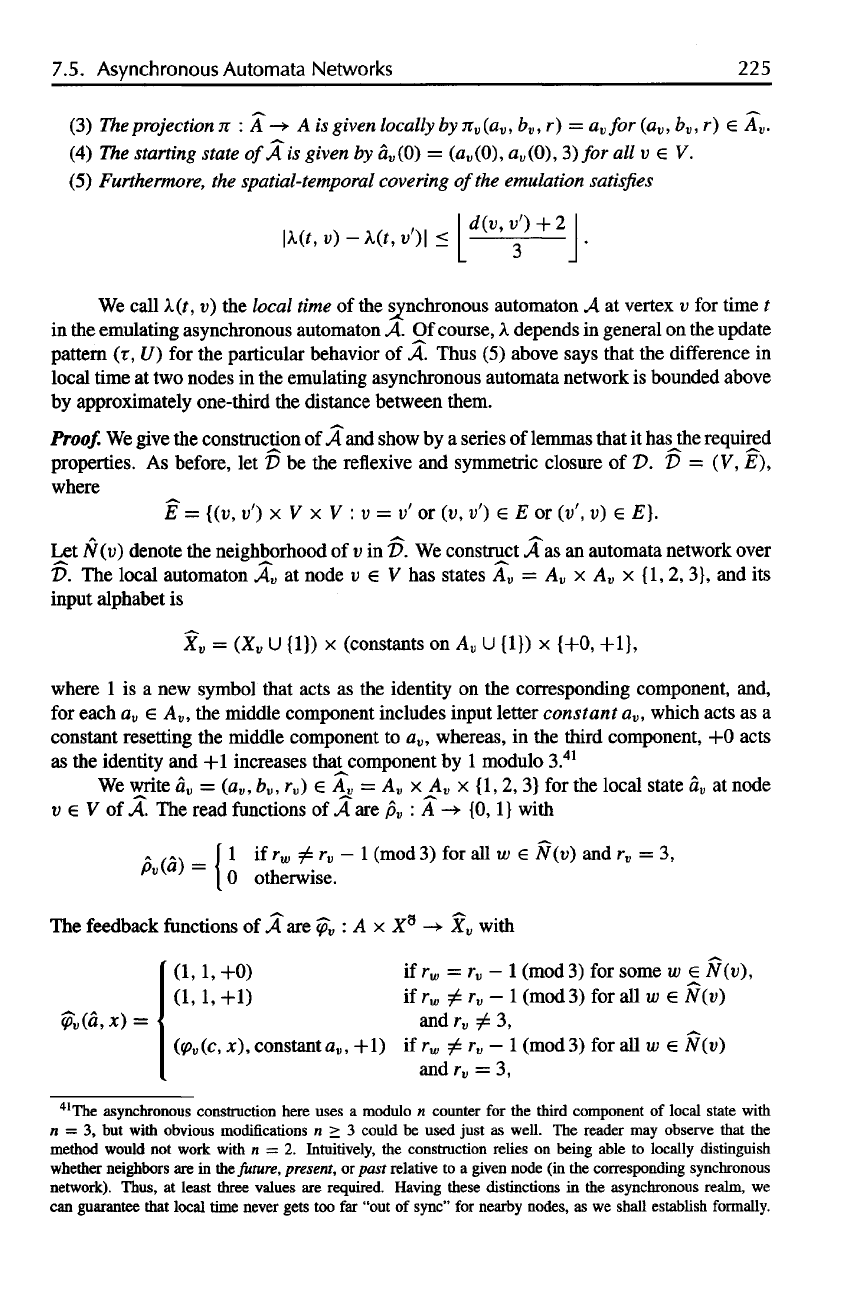
7.5.
Asynchronous
Automata Networks
225
(3)
The
projection
TT
: A
—>•
A is
given
locally
by
n
v
(a
v
,
b
v
, r) =
a
v
for (a
v
,
b
v
, r) € A
v
.
(4) The
starting
state
of
A is
given
by
a
v
(0)
=
(a
v
(Q),
a
v
(ty,
3) for all v e V.
(5)
Furthermore,
the
spatial-temporal
covering
of
the
emulation
satisfies
We
call
X.(t,
v) the
local
time
of the
synchronous automaton
A at
vertex
v for
time
t
in the
emulating asynchronous automaton
A. Of
course,
A
depends
in
general
on the
update
pattern
(T, (7) for the
particular behavior
of A.
Thus
(5)
above says that
the
difference
in
local
time
at two
nodes
in the
emulating asynchronous automata network
is
bounded above
by
approximately one-third
the
distance between them.
Proof.
We
give
the
construction
of A and
show
by a
series
of
lemmas that
it
hasthe required
properties.
As
before,
let
T>
be the
reflexive
and
symmetric closure
of
T>.
D = (V, E),
where
Let
N(v~)
denote
the
neighborhood
of v in
T>.
We
construct
A as an
automata network over
T>.
The
local
automaton
A
v
at
node
v e V has
states
A
v
— A
v
x A
v
x {1, 2, 3}, and its
input alphabet
is
where
1 is a new
symbol that acts
as the
identity
on the
corresponding component, and,
for
each
a
v
e A
v
, the
middle component includes input letter
constant
a
v
,
which acts
as a
constant resetting
the
middle component
to a
v
,
whereas,
in the
third component,
+0
acts
as
the
identity
and +1
increases that^component
by 1
modulo 3.
41
We
write
a
v
=
(a
v
,
b
v
, r
v
) e A
v
= A
v
x A
v
x {1, 2, 3} for the
local state
a
v
at
node
v
€ V of A. The
read
functions
of A are p
v
: A -+
{0,1} with
The
feedback
functions
of A are
<p
v
: A x X
9
-> X
v
with
41
The
asynchronous construction here uses
a
modulo
n
counter
for the
third component
of
local state with
n
= 3, but
with obvious modifications
n > 3
could
be
used just
as
well.
The
reader
may
observe that
the
method would
not
work with
n — 2.
Intuitively,
the
construction relies
on
being able
to
locally distinguish
whether neighbors
are in the
future, present,
or
past relative
to a
given node
(in the
corresponding synchronous
network). Thus,
at
least
three values
are
required. Having these distinctions
in the
asynchronous realm,
we
can
guarantee that
local
time never gets
too far
"out
of
sync"
for
nearby
nodes,
as we
shall establish formally.
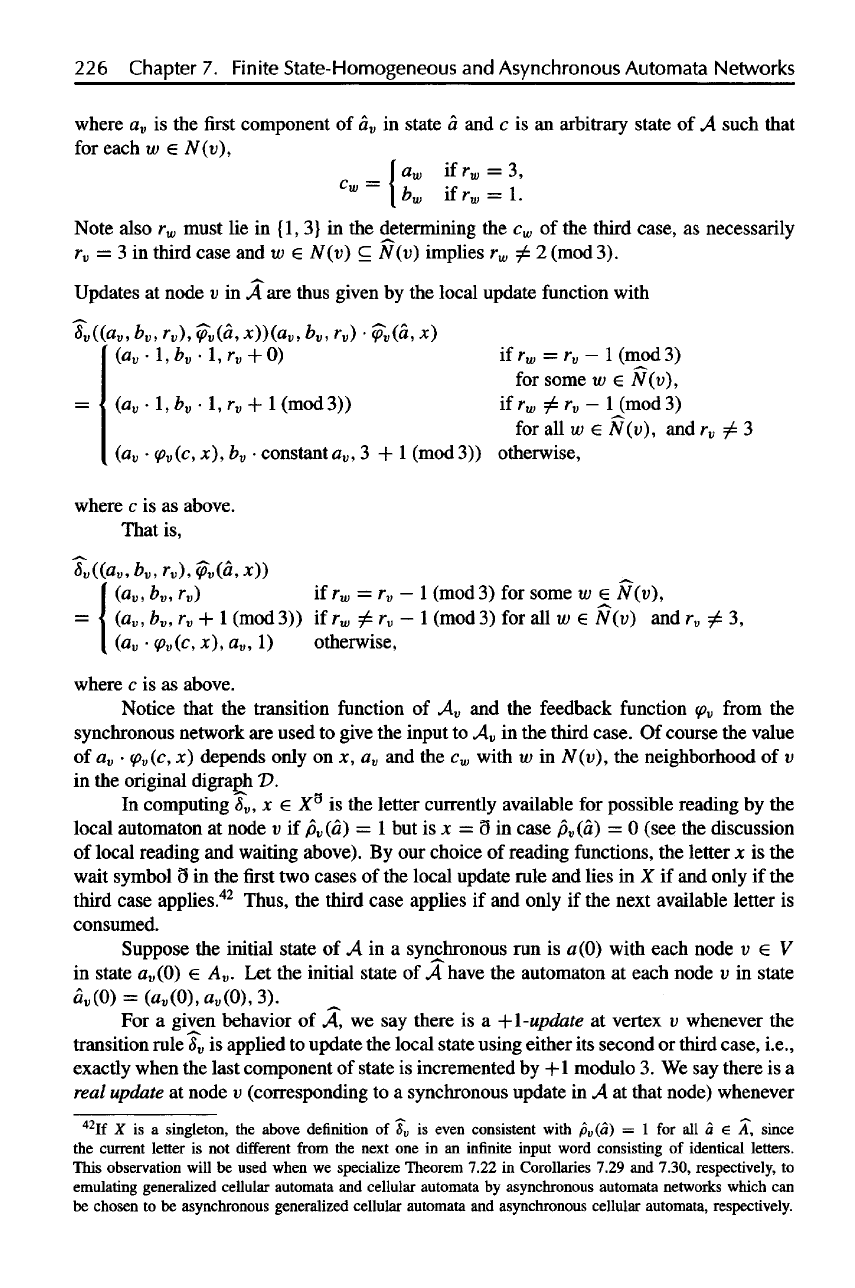
226
Chapter
7.
Finite
State-Homogeneous
and
Asynchronous
Automata Networks
where
a
v
is the first
component
of a
v
in
state
a and c is an
arbitrary state
of A
such that
for
each
w e
N(v),
Note
also
r
w
must
lie in {1, 3} in the
determining
the c
w
of the
third case,
as
necessarily
r
v
= 3 in
third case
and w e
N(v)
c
N(v) implies
r
w
^ 2
(mod
3).
Updates
at
node
v in A are
thus given
by the
local update
function
with
where
c is as
above.
That
is,
if
r
w
= r
v
— 1
(mod
3) for
some
w e
N(v),
if
r
w
^ r
v
— 1
(mod
3) for all w e
N(v)
and r
v
^ 3,
otherwise,
where
c is as
above.
Notice that
the
transition
function
of A
v
and the
feedback
function
p
v
from
the
synchronous network
are
used
to
give
the
input
to A
v
in the
third
case.
Of
course
the
value
of
a
v
•
(p
v
(c,
x)
depends only
on x, a
v
and the c
w
with
w in
N(v),
the
neighborhood
of v
in
the
original digraph
V.
In
computing
8
V
, x e X
s
is the
letter currently available
for
possible reading
by the
local automaton
at
node
v if
p
v
(a)
= 1 but is x = 3 in
case ^(a)
= 0
(see
the
discussion
of
local
reading
and
waiting above).
By our
choice
of
reading
functions,
the
letter
x is the
wait symbol
9 in the first two
cases
of the
local update rule
and
lies
in X if and
only
if the
third case applies.
42
Thus,
the
third case applies
if and
only
if the
next available letter
is
consumed.
Suppose
the
initial state
of A in a
synchronous
run is
0(0) with each node
v £ V
in
state a
v
(Q)
e A
v
. Let the
initial state
of A
have
the
automaton
at
each node
v in
state
fi
B
(0) =
(fl
B
(0),fl
w
(0),3).
For a
given behavior
of A, we say
there
is a
-\-l-update
at
vertex
v
whenever
the
transition rule
8
V
is
applied
to
update
the
local state using either
its
second
or
third case, i.e.,
exactly when
the
last component
of
state
is
incremented
by -f 1
modulo
3. We say
there
is a
real
update
at
node
v
(corresponding
to a
synchronous update
in A at
that node) whenever
42
If
X is a
singleton,
the
above definition
of S
v
is
even consistent with p
v
(a)
= 1 for all a € A,
since
the
current
letter
is not
different
from
the
next
one in an
infinite
input word consisting
of
identical
letters.
This
observation will
be
used when
we
specialize
Theorem 7.22
in
Corollaries
7.29
and
7.30, respectively,
to
emulating
generalized
cellular automata
and
cellular automata
by
asynchronous automata networks which
can
be
chosen
to be
asynchronous generalized cellular automata
and
asynchronous cellular automata, respectively.
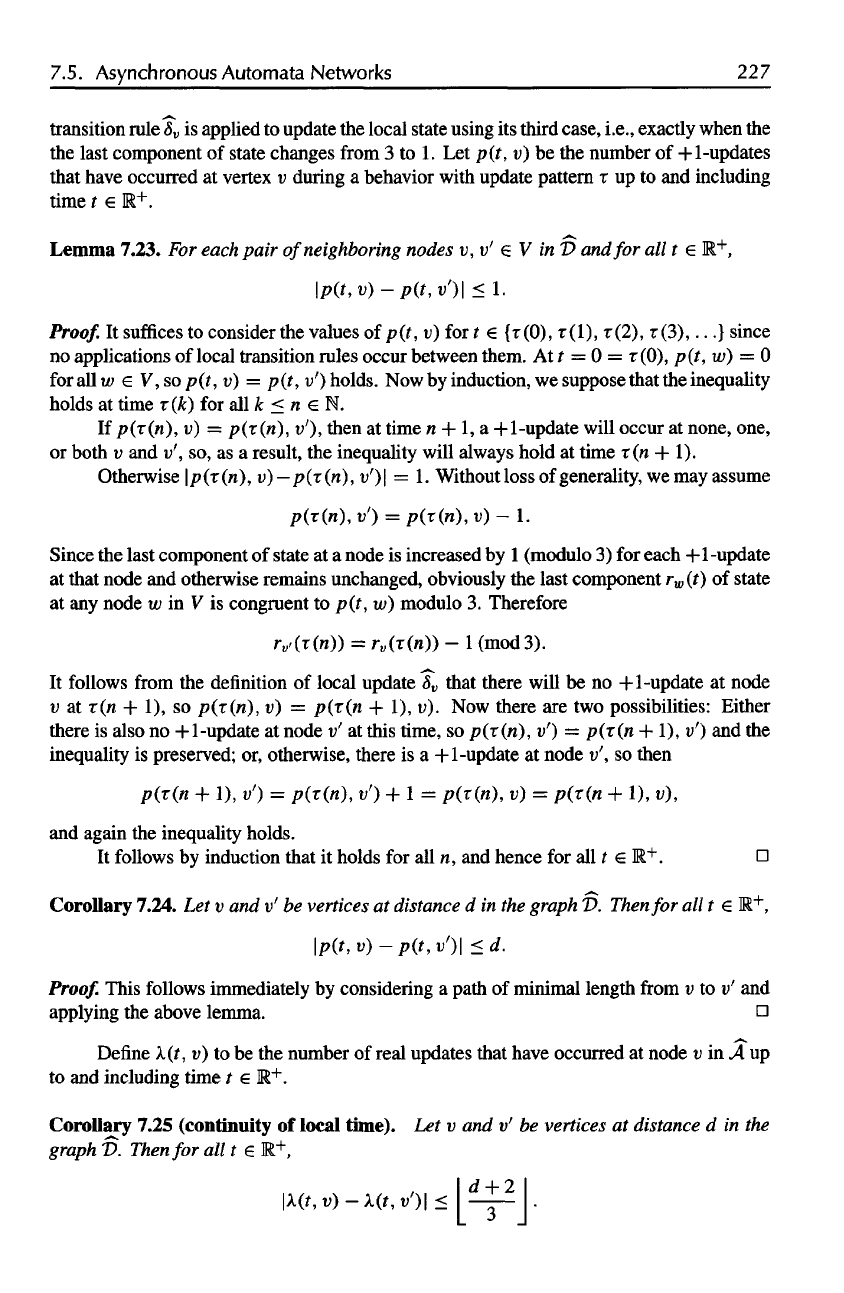
7.5.
Asynchronous
Automata
Networks
227
transition rule
8
V
is
applied
to
update
the
local state using
its
third case, i.e., exactly when
the
the
last component
of
state changes
from
3 to 1. Let
p(t,
v) be the
number
of
+l-updates
that have occurred
at
vertex
v
during
a
behavior with update pattern
T up to and
including
time
t e R
+
.
Lemma
7.23.
For
each pair
of
neighboring
nodes
v, v
f
€ V in
T>
and
for all t e E
+
,
Proof.
It
suffices
to
consider
the
values
of p(t , v) for t €
(r(0),
T
(1), r(2),
r
(3),
. . .}
since
no
applications
of
local
transition
rules
occur between them.
At t = 0 =
r(0),
p(t , w) = 0
for
all w
eV,sop(t,v)
=
p(t,
i/)
holds.
Now by
induction,
we
suppose that
the
inequality
holds
at
time r(k)
for all k < n e N.
If
p(r(n),
v) =
p(r(n),
v
1
), then
at
time
n + 1, a
+l-update
will occur
at
none, one,
or
both
v and v', so, as a
result,
the
inequality will always hold
at
time
i(n + 1).
Otherwise \p(r(n), v)—p(r(ri),
t/)|
= 1.
Without loss
of
generality,
we may
assume
Since
the
last component
of
state
at a
node
is
increased
by 1
(modulo
3) for
each
+1
-update
at
that node
and
otherwise remains unchanged, obviously
the
last component
r
w
(t) of
state
at
any
node
w in V is
congruent
to p(t , w}
modulo
3.
Therefore
It
follows
from
the
definition
of
local update
8
V
that there will
be no +1
-update
at
node
v
at r(n + 1), so
p(i(n),
v) =
p(r(n
+ 1), v). Now
there
are two
possibilities:
Either
there
is
also
no
+l-update
at
node
v' at
this time,
so
p(r(n),
v') =
p(r(n
+ 1), v') and the
inequality
is
preserved;
or,
otherwise, there
is a +1
-update
at
node
v', so
then
and
again
the
inequality holds.
It
follows
by
induction that
it
holds
for all n, and
hence
for all t e R
+
. n
Corollary 7.24.
Let v and v' be
vertices
at
distance
d in the
graph
D.
Then
for all t € R,
Proof.
This follows immediately
by
considering
a
path
of
minimal length
from
v to v' and
applying
the
above lemma.
Define
A(f,
v) to be the
number
of
real updates that have occurred
at
node
v in A up
to
and
including time
t e
1R
+
.
Corollary
7.25
(continuity
of
local time).
Let v and v' be
vertices
at
distance
d in the
graph
P.
Then
for all t € R
+
,
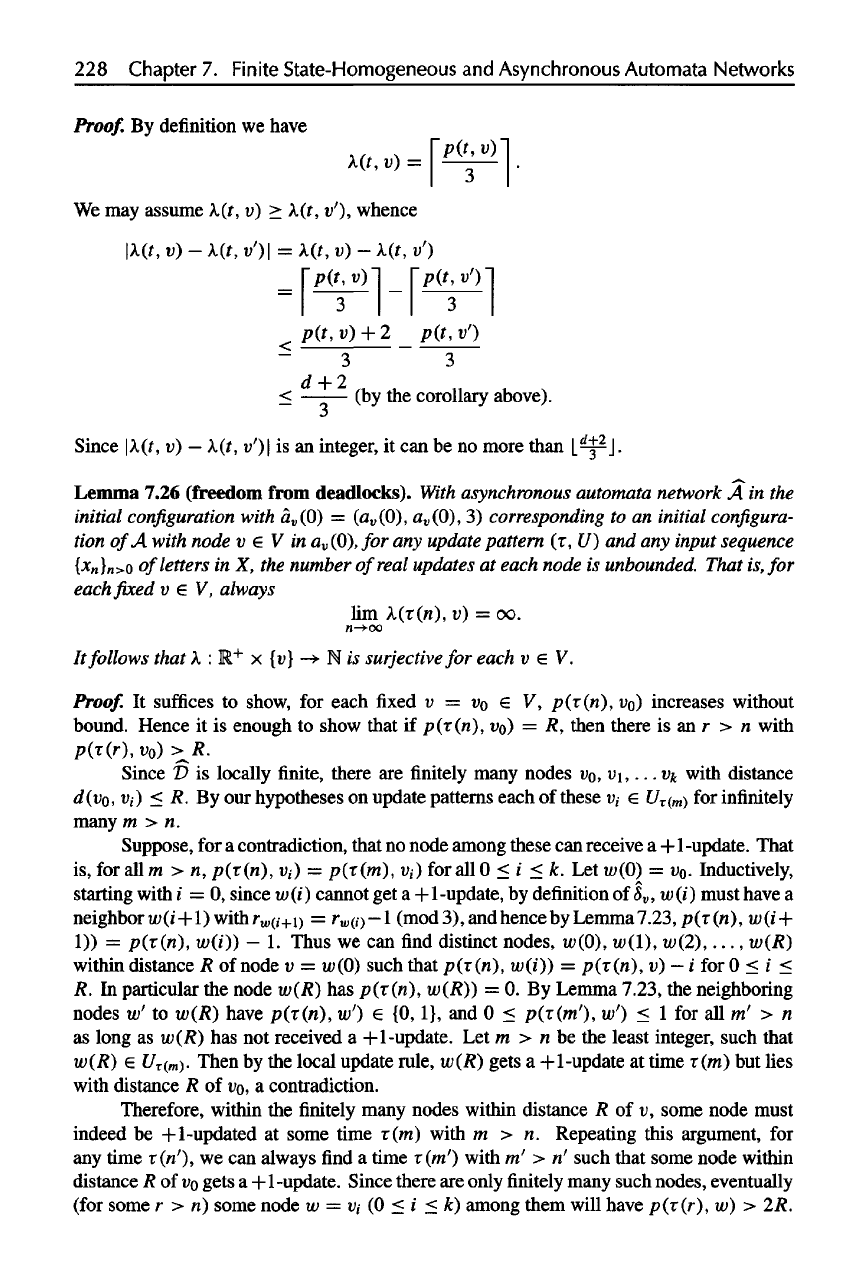
228
Chapter
7.
Finite
State-Homogeneous
and
Asynchronous
Automata Networks
Proof.
By
definition
we
have
We
may
assume .(t,
v)
.(f, v'), whence
Since
(t, v) —
A.(f,
i/)|
is an
integer,
it can be no
more than
•
Lemma 7.26 (freedom from
deadlocks).
With
asynchronous
automata network
A in the
initial
configuration
with a
v
(0)
=
(a
v
(0),
a
v
(0),
3)
corresponding
to an
initial
configura-
tion
of
A
with
node
v e V in
a
v
(0),for
any
update
pattern
( , U) and any
input
sequence
{x
n
}n>o
of
letters
in X, the
number
of
real
updates
at
each
node
is
unbounded.
That
is, for
each
fixed v € V,
always
It
follows
that
: R
+
x [v] ->• N is
surjective
for
each
v V.
Proof.
It
suffices
to
show,
for
each
fixed v =
VQ
e V, p(
(n),
VQ)
increases without
bound.
Hence
it is
enough
to
show that
if p(
(n),
VQ)
= R,
then there
is an r > n
with
p(
(r),
V
0
)
>^R.
Since
D is
locally
finite,
there
are finitely
many nodes
V
0
,
v
1
,...
V
k
with
distance
d(v
o
,
v
i
) < R. By our
hypotheses
on
update patterns each
of
these
v
t
e U (
m
) for
infinitely
many
m > n.
Suppose,
for a
contradiction, that
no
node among these
can
receive
a+1-update.
That
is,
for all m > n, p(
(n), v
i
,)
= p(
(m),
v
i
) for all 0 < i < k. Let
w(0)
=
VQ.
Inductively,
starting with
i = 0,
since iu(i) cannot
get a
+1-update,
by
definition
of ,
w(i) must have
a
neighbor
Wi(i+l)
with
r
w
(i+1)
=
r(i)
-1
(mod
3)—
1
(mod
3), and
hence
by
Lemma 7.23,
p(
(n), w(i+
1))
= p(
(n), w(0)
—
1.
Thus
we can find
distinct nodes, w(0), w(l), u;(2),..., w(R)
within
distance
R of
node
v =
w(0)
such that
p(
(n), w(/))
= p(
(n),
v)
—
i for 0 i
R. In
particular
the
node w(R)
has p(
(n), w(R))
= 0. By
Lemma 7.23,
the
neighboring
nodes
w' to
w(R) have
p(
(n),
w') {0, 1}, and 0 < p(
(m'),
w) < 1 for all m' > n
as
long
as
w(R)
has not
received
a
+1-update.
Let m > n be the
least integer, such that
w(R)
€ U
(
m
). Then
by the
local
update rule, w(R) gets
a
+l-update
at
time r(m)
but
lies
with distance
R of
VQ,
a
contradiction.
Therefore,
within
the finitely
many nodes within distance
R of v,
some node must
indeed
be
+l-updated
at
some time r(m) with
m > n.
Repeating this argument,
for
any
time
r(n'),
we can
always
find a time
r(m') with
m' > n'
such that some node within
distance
R of
VQ
gets
a
+1-update.
Since there
are
only
finitely
many such nodes, eventually
(for
some
r > n)
some node
w =
t>,
(0 < i < k)
among them will have
p(
(r),
w) > 2R.
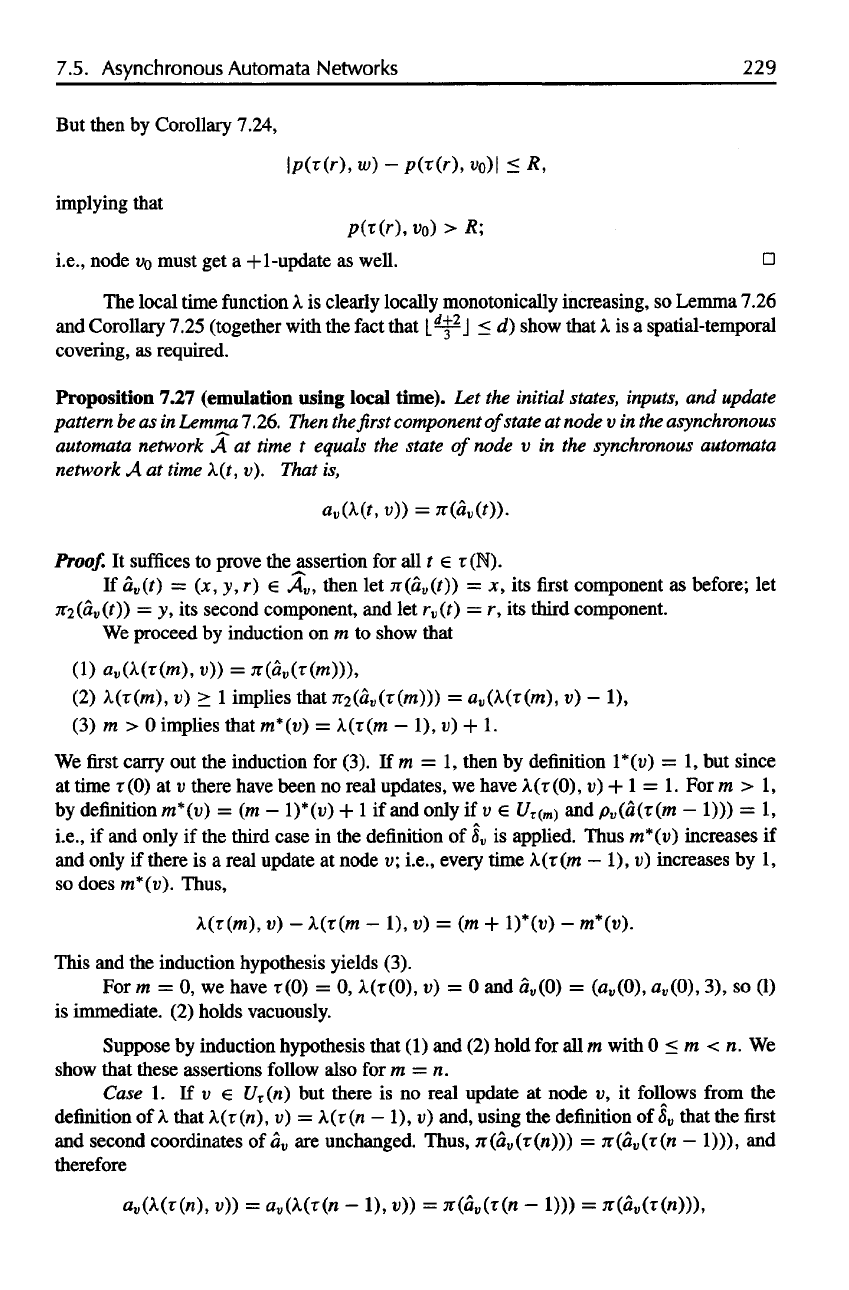
7.5.
Asynchronous
Automata Networks
229
But
then
by
Corollary 7.24,
implying
that
i.e., node
VQ
must
get a +1
-update
as
well.
The
local tune
function
A
is
clearly locally monotonically increasing,
so
Lemma 7.26
and
Corollary 7.25 (together with
the
fact
that
[^
J
< d
show that
X
is a
spatial-temporal
covering,
as
required.
Proposition
7.27 (emulation using
local
time).
Let the
initial
states,
inputs,
and
update
pattern
be as in
Lemma 7.26.
Then
the first
component
of
state
at
node
v in the
asynchronous
automata
network
A at
time
t
equals
the
state
of
node
v in the
synchronous
automata
network
A at
time
k(t,
i>).
That
is,
Proof.
It
suffices
to
prove
the
assertion
for all t e
r(N).
If
a
v
(t)
— (x, y, r) e A
v
,
then
let
n(a
v
(t))
= x, its first
component
as
before;
let
7*2
(0v
(0) = v, its
second component,
and let
r
v
(t)
= r, its
third component.
We
proceed
by
induction
on m to
show that
(2)
A.(r(m),
u) > 1
implies that 7r2(a
r
(r(m)))
=
a
v
(X(r(m),
v)
—
1),
(3)
m > 0
implies that
m*(u)
=
A(r(m
- 1), u) + 1.
We
first
carry
out the
induction
for
(3).
If m = 1,
then
by
definition l*(v)
= 1, but
since
at
time r(0)
at v
there have been
no
real updates,
we
have A(r(0),
u) +1 = 1. For m > 1,
by
definition
m*(u)
= (m
—
l)*(v)
+ 1 if and
only
if v e
£/
T
(
m
)
and
p
v
(a(r(m
—
1)))
= 1,
i.e.,
if and
only
if the
third case
in the
definition
of
8
V
is
applied. Thus
m*(i>)
increases
if
and
only
if
there
is a
real update
at
node
v;
i.e., every time
A.(r(m
—
1), v)
increases
by 1,
so
does
ra*(u).
Thus,
This
and the
induction hypothesis yields (3).
For
m = 0, we
have r(0)
= 0,
X(r(0),
u) = 0 and
a«(0)
=
(a
v
(0),
0
V
(0),
3), so (1)
is
immediate.
(2)
holds vacuously.
Suppose
by
induction hypothesis that
(1) and (2)
hold
for all m
with
0 < m < n. We
show
that these assertions
follow
also
for m = n.
Case
1. If v €
U
r
(ri)
but
there
is no
real update
at
node
v, it
follows
from
the
definition
of
A.
that
X(r(«),
v) =
X(r(n
—
1), v)
and, using
the
definition
of
V
that
the first
and
second coordinates
of a
v
are
unchanged. Thus, n(a
v
(r(n)))
=
n(a
v
(r(n
—
1))),
and
therefore
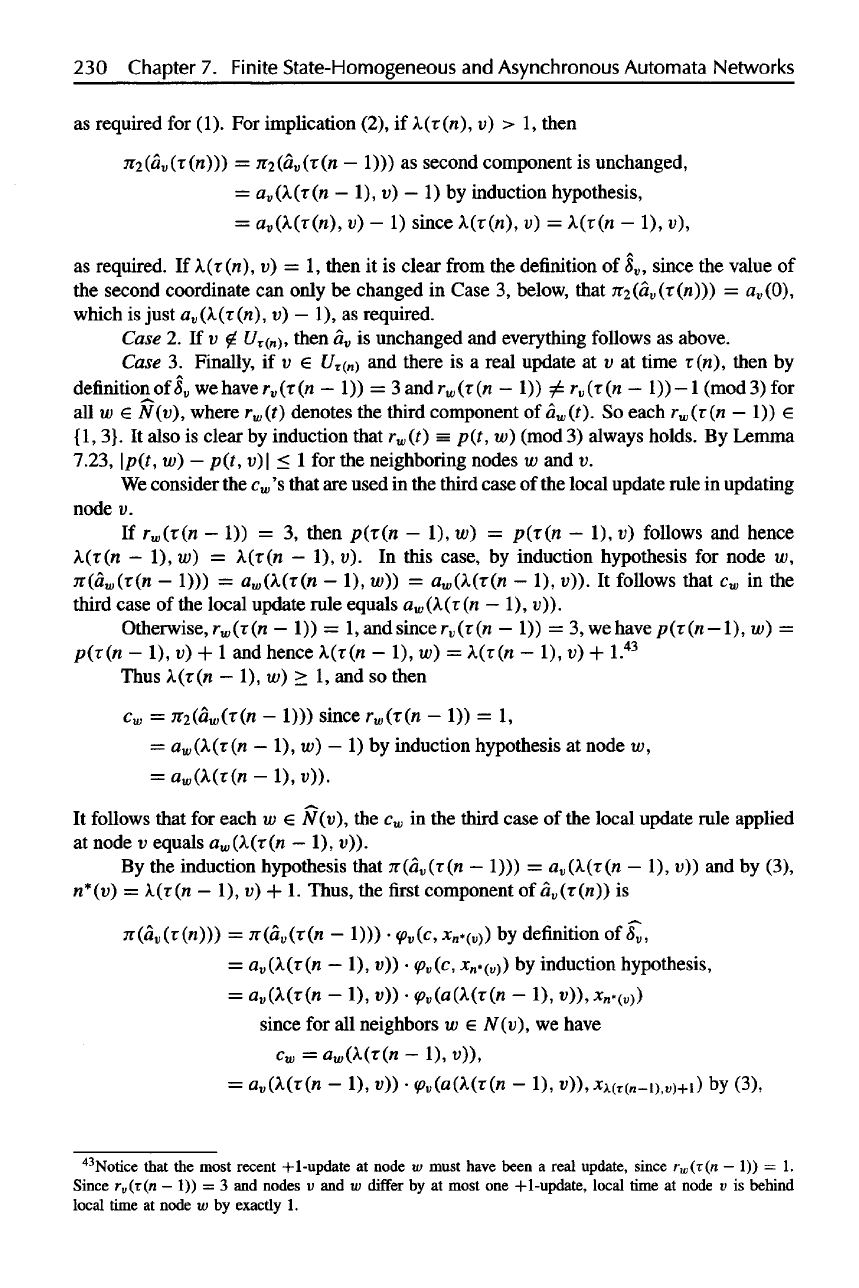
230
Chapter
7.
Finite State-Homogeneous
and
Asynchronous
Automata Networks
as
required
for
(1).
For
implication (2),
if
A(r(n),
v) > 1,
then
(a
v
(r (n)}}
=
n2(a
v
(r(n
—
1)))
as
second component
is
unchanged,
=
a
v
(k(t(n
— 1), v) — 1) by
induction hypothesis,
=
a
v
(k(r(ri),
v)
—
1)
since
A(r(n),
*>)
=
A(r(n
—
1), u),
as
required.
If
A.(r(n),
v) = 1,
then
it is
clear
from
the
definition
of 8
V
,
since
the
value
of
the
second coordinate
can
only
be
changed
in
Case
3,
below, that 7^(0,, (r(n)))
=
a
v
(Q),
which
is
just a
v
(X(r(n),
u)
—
1), as
required.
Case
2.1fvg
U
T
(
n
),
then
a
v
is
unchanged
and
everything follows
as
above.
Case
3.
Finally,
if v e
T
(n)
and
there
is a
real update
at v at
time r(n), then
by
definition
of S
v
we
haver,; (r(n
—
1)) =
3andr
w
(r(n
—
1)) ^
r
v
(r(n
— 1))
—1
(mod3)for
all w €
N(v), where r
w
(t) denotes
the
third component
of
a
w
(t).
So
each
r
w
(t(n
— 1)) G
{1,3}.
It
also
is
clear
by
induction that r
w
(t)
=
p(t,
w)
(mod
3)
always holds.
By
Lemma
7.23, \p(t,
w) —
p(t,
u)| < 1 for the
neighboring nodes
w and v.
We
consider
the
c
w
's that
are
used
in the
third
case
of the
local update rule
in
updating
node
v.
If
r
w
(t(n
— 1)) = 3,
then p(r(n
— 1), w) =
p(r(n
— 1), v)
follows
and
hence
A(r(n
— 1), w) =
k(r(n
— 1), u). In
this
case,
by
induction hypothesis
for
node
w,
7i(a
w
(t(n
—
1)))
=
a
w
(A(r(n
—
1), w)} =
a
w
(X(r(n
— 1),
u)).
It
follows that
c
w
in the
third case
of the
local
update rule equals a
w
(X(r(n
— 1),
u)).
Otherwise,
r
w
(r(n
— 1)) = 1, and
since
r
v
(r(n
— 1)) = 3,
wehave/?(r(n
—
1), w) =
p(r(n
- 1), v) + 1
and
hence X(r(n
- 1),
w)
=
X(r(n
- 1), v) +
I.
43
Thus
A.(r(n
—
1), w) > 1, and so
then
c
w
=
Jt2(a
w
(T(n
-
1))) since
r
w
(r(n
- 1)) = 1,
=
a
w
(X(t(n
— 1), w} — 1) by
induction hypothesis
at
node
w,
=
a
w
(X(T(n
- 1),
w)).
It
follows that
for
each
u; e
N(v),
the
Cu,
in the
third case
of the
local update rule applied
at
node
v
equals
a
w
(k(r(n
— 1),
u)).
By
the
induction hypothesis that n(a
v
(T(n
—
1)))
=
a
v
(^(r(n
— 1), u)) and by
(3),
n*(u)
=
A.(r(n
—
1), u) + 1.
Thus,
the first
component
of
a
v
(z(ri)}
is
43
Notice
that
the
most recent
+l-update
at
node
w
must have been
a
real update, since
r
w
(r(n
— 1)) = 1.
Since
r
v
(r(n
—
1)) = 3 and
nodes
v and w
differ
by at
most
one
+l-update,
local time
at
node
v is
behind
local time
at
node
w by
exactly
1.
